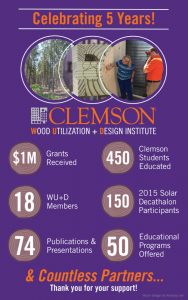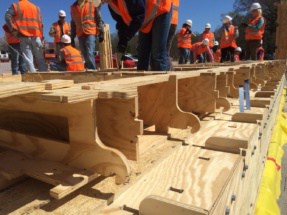
Clemson’s Wood Utilization + Design Institute Celebrates Five Years Promoting “Wood is Good”
CLEMSON – Trees have provided a viable building material for centuries, and although steel and concrete have taken center stage in contemporary construction, lumber is making a comeback.
Building with wood has a number of advantages. For the past five years, Clemson University’s Wood Utilization + Design Institute (WU+D) has been educating individuals in the Southeast about these benefits, including the fact wood takes less energy to produce than most other building materials, giving it a lower carbon footprint. In addition to being renewable and aesthetically pleasing, wood also is stronger, can resist heat and absorbs sound.
Education and innovation
Established in 2013 as an innovation hub for South Carolina’s $21 billion forest products industry, WU+D serves Clemson’s students and faculty as well as industry professionals. Participants learn from a number of faculty from architecture, automotive engineering, construction science and management and material science.
“One of our goals is to increase the number of students who understand the value of using wood in construction and prepare them to be the next generation of architects, engineers, foresters and scientists,” said Pat Layton, director of WU+D.
Over the past five years, around 450 students have been wood educated and teaching activities have expanded to include more Clemson campuses.
“We have Creative Inquiry projects and teach a wood engineering class every spring semester to engage students in hands-on, experiential learning that will help them understand the benefits of building with wood. Architecture students are exposed to wood as a building material in their structure class and, usually every semester, at least one studio includes wood as a choice or featured project,” said Layton.
In 2015, 150 students and faculty participated in the Solar Decathlon using the sim[PLY] framing system developed by assistant architecture professor Dustin Albright and associate architecture professor Dan Harding. Both are also WU+D fellows.
Sim[PLY] is a light framing system that uses prefabricated framing components for rapid, intuitive assembly, optimal thermal performance, and easy disassembly and modification. It is designed to build on the benefits of traditional light wood construction while offering precision, safety, constructability, reusability, systems coordination and thermal performance.
“The process of developing sim[PLY] has drawn on the collective knowledge of faculty and students from architecture, civil engineering, forestry and packaging science, among others. It is a robust and collaborative research endeavor, drawing deeply on the support and enthusiasm found in WU+D and its partners,” said Albright.

Collaborative research
Beyond education, WU+D fosters collaborative research among campus, industry and public service centers. These relationships have led to new product testing and development, including several key corporate contract research opportunities that are supported by students and faculty. Founding WU+D Institute member Huber Engineered Woods worked with Institute researchers on one of their innovative ZIPSystem® products before introducing it to the market.
Other research has involved using cross-laminated timber (CLT) to construct wind-resistant buildings and develop design guides related to use of CLT for building diaphragms.
Michael Stoner, a Clemson civil engineering doctoral student, has been working with WU+D to test the debris impact resistance of CLT in the event of a tornado or hurricane. As a doctoral student, he is heavily involved in research and industry relations at the lab on campus.
“Significant innovations in engineered wood products have led to a revolution in the way we build with wood,” Stoner said. “The study of cross-laminated timber has begun to reveal the potential to build taller, stronger and safer wood buildings.”
Currently, a new Built Environment Lab (BEL) is being renovated at Clemson University in Pendleton to house even more architecture, construction science and forestry research initiatives. The focus of this new lab will be on the design and construction needs of South Carolina’s built environment. These needs will fall into two categories: materials and structures.
Graham Montgomery, a Clemson civil engineering alumnus with Britt, Peters & Associates Inc., said partnerships forged between the WU+D Institute and wood industry benefit everyone.
“WU+D builds bonds between industry and education and allows us to do more together than on our own,” Montgomery said. “It utilizes each of its partners and its own strengths to help push the use of one of our greatest natural, renewable resources.”
The “wood is good” message of the Institute is reaching the masses. According to Layton, WU+D has met with more than 10 companies who are interested in coming to the South as well as some companies that will introduce new products that will come from the South.
“This is indicative of the impacts wood has on economic development and research. Wood is a natural, living material people can connect with,” Layton said. “People find comfort and warmth in wood. Wood is good and WU+D is committed to helping find more ways to use wood in the building industry. The Institute will continue to attract partners and members, and will continue to have an excellent public and private research program that develops new products and uses for wood, leading to overall increased wood use.”
Wood Utilization + Design Institute
Clemson University’s Wood Utilization + Design Institute (WU+D) was established in 2013 as a multidisciplinary engine of innovation where foresters, architects, engineers, constructors and building industry stakeholders coalesce to design advancements in wood-based construction materials to compete with steel, concrete and other materials currently used in nonresidential construction.






